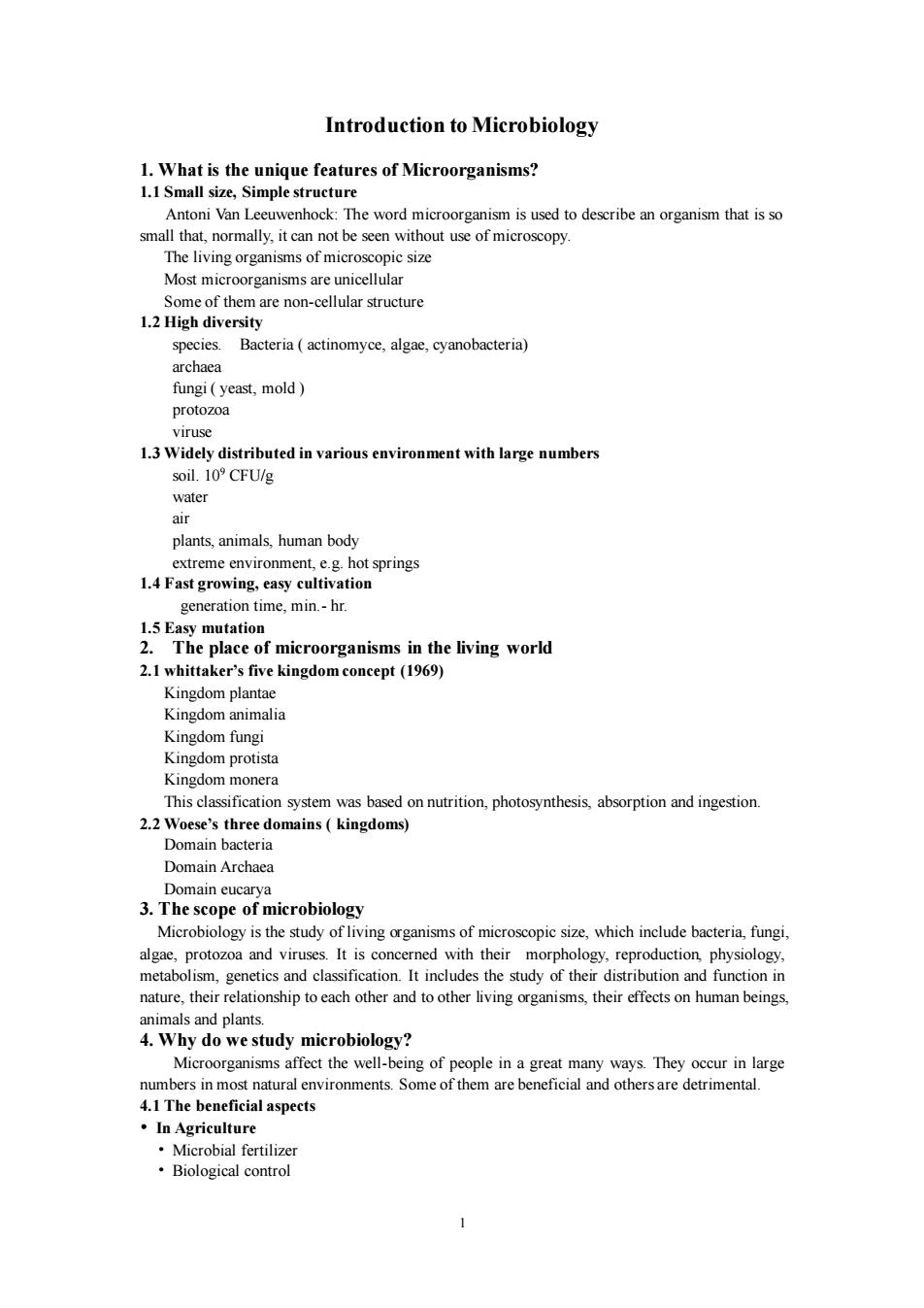正在加载图片...

1 Introduction to Microbiology 1. What is the unique features of Microorganisms? 1.1 Small size, Simple structure Antoni Van Leeuwenhock: The word microorganism is used to describe an organism that is so small that, normally, it can not be seen without use of microscopy. The living organisms of microscopic size Most microorganisms are unicellular Some of them are non-cellular structure 1.2 High diversity species. Bacteria ( actinomyce, algae, cyanobacteria) archaea fungi ( yeast, mold ) protozoa viruse 1.3 Widely distributed in various environment with large numbers soil. 109 CFU/g water air plants, animals, human body extreme environment, e.g. hot springs 1.4 Fast growing, easy cultivation generation time, min.- hr. 1.5 Easy mutation 2. The place of microorganisms in the living world 2.1 whittaker’s five kingdom concept (1969) Kingdom plantae Kingdom animalia Kingdom fungi Kingdom protista Kingdom monera This classification system was based on nutrition, photosynthesis, absorption and ingestion. 2.2 Woese’s three domains ( kingdoms) Domain bacteria Domain Archaea Domain eucarya 3. The scope of microbiology Microbiology is the study of living organisms of microscopic size, which include bacteria, fungi, algae, protozoa and viruses. It is concerned with their morphology, reproduction, physiology, metabolism, genetics and classification. It includes the study of their distribution and function in nature, their relationship to each other and to other living organisms, their effects on human beings, animals and plants. 4. Why do we study microbiology? Microorganisms affect the well-being of people in a great many ways. They occur in large numbers in most natural environments. Some of them are beneficial and others are detrimental. 4.1 The beneficial aspects • In Agriculture • Microbial fertilizer • Biological control1 Introduction to Microbiology 1. What is the unique features of Microorganisms? 1.1 Small size, Simple structure Antoni Van Leeuwenhock: The word microorganism is used to describe an organism that is so small that, normally, it can not be seen without use of microscopy. The living organisms of microscopic size Most microorganisms are unicellular Some of them are non-cellular structure 1.2 High diversity species. Bacteria ( actinomyce, algae, cyanobacteria) archaea fungi ( yeast, mold ) protozoa viruse 1.3 Widely distributed in various environment with large numbers soil. 109 CFU/g water air plants, animals, human body extreme environment, e.g. hot springs 1.4 Fast growing, easy cultivation generation time, min.- hr. 1.5 Easy mutation 2. The place of microorganisms in the living world 2.1 whittaker’s five kingdom concept (1969) Kingdom plantae Kingdom animalia Kingdom fungi Kingdom protista Kingdom monera This classification system was based on nutrition, photosynthesis, absorption and ingestion. 2.2 Woese’s three domains ( kingdoms) Domain bacteria Domain Archaea Domain eucarya 3. The scope of microbiology Microbiology is the study of living organisms of microscopic size, which include bacteria, fungi, algae, protozoa and viruses. It is concerned with their morphology, reproduction, physiology, metabolism, genetics and classification. It includes the study of their distribution and function in nature, their relationship to each other and to other living organisms, their effects on human beings, animals and plants. 4. Why do we study microbiology? Microorganisms affect the well-being of people in a great many ways. They occur in large numbers in most natural environments. Some of them are beneficial and others are detrimental. 4.1 The beneficial aspects • In Agriculture • Microbial fertilizer • Biological control